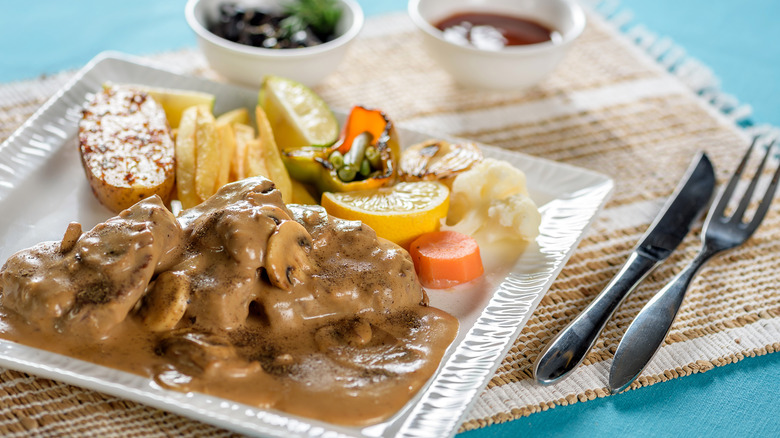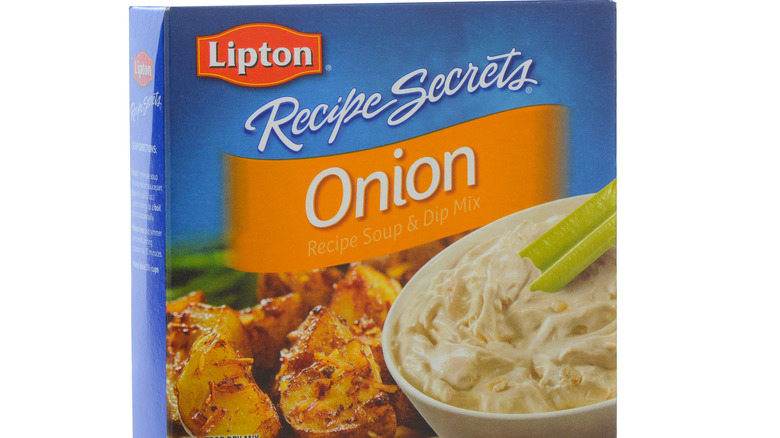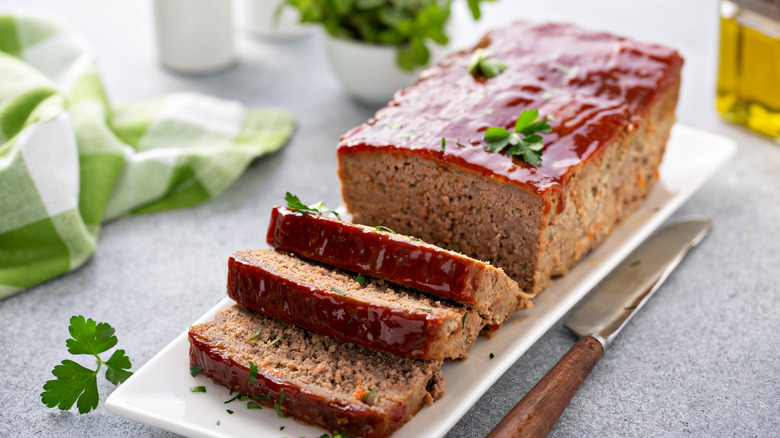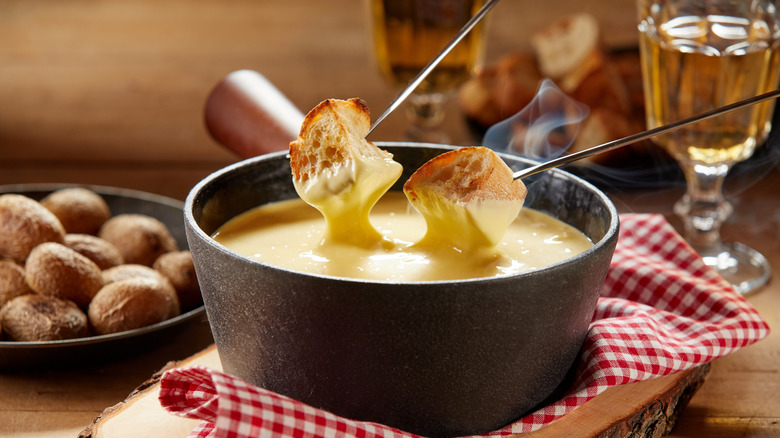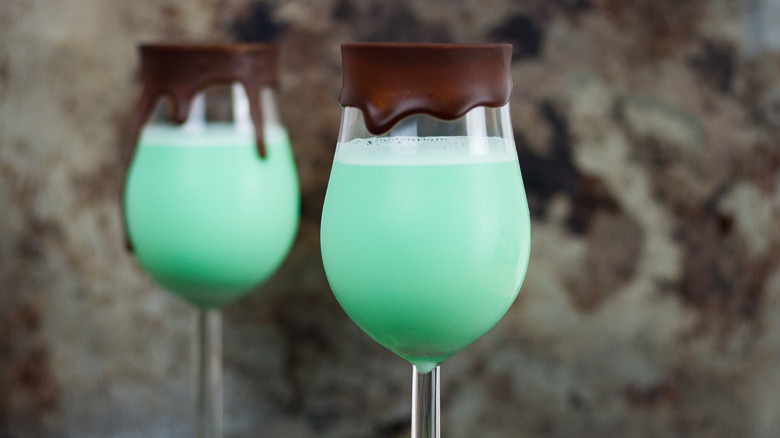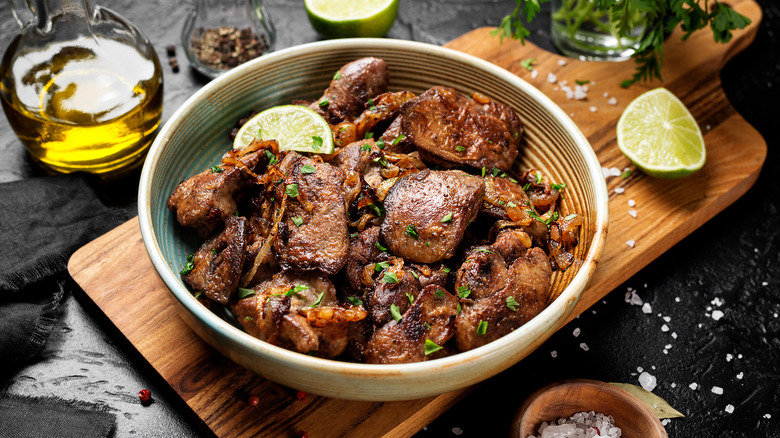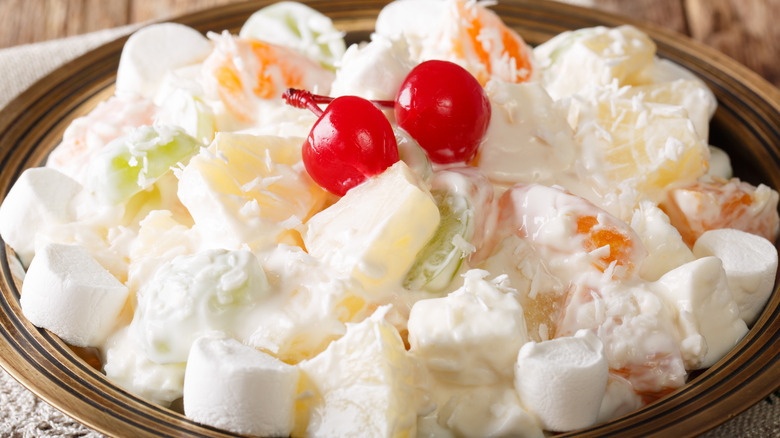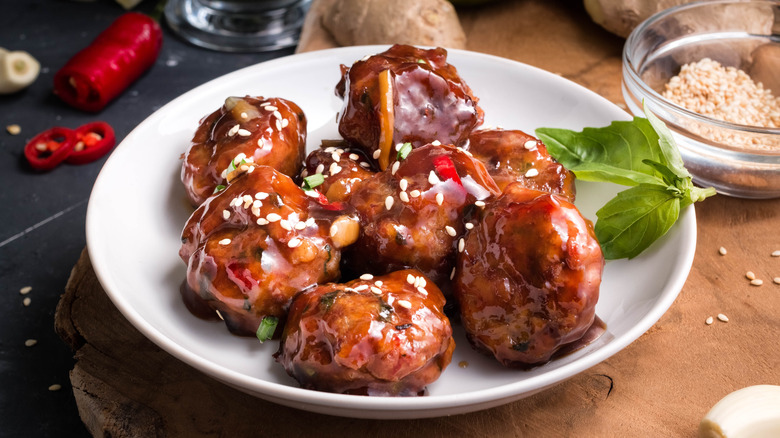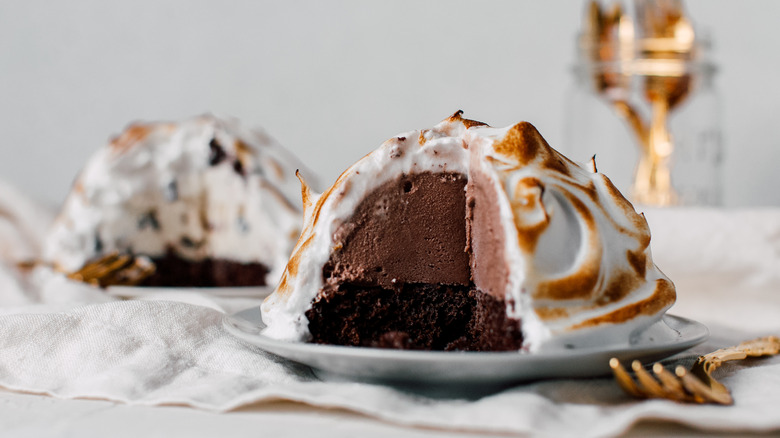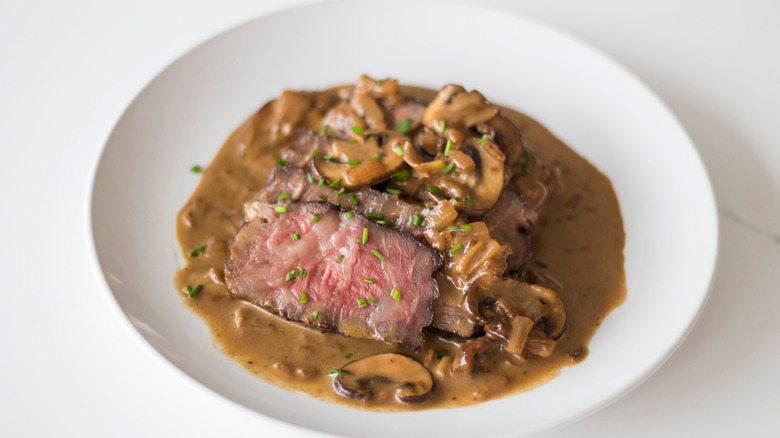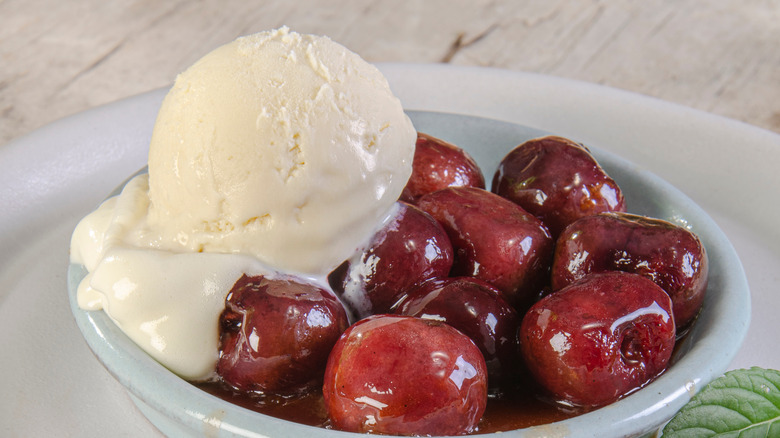Foods From The 1960s That Are Weirdly Making A Comeback
No one can deny that the 1960s introduced America to a wide variety of novelties and oddities that just don't make sense to eat in the 21st century. A wave of new ingredients and a shift towards convenience cooking all resulted in some seriously weird foods that never made it out of the decade (via VICE). Some items — like the tuna-berry sandwich, ham basted with 7-Up, and ham-banana rolls — vanished with the '60s, but other items that should have seemingly faded away have made a comeback, So Yummy reports. A variety of classic foods, like deviled eggs, sloppy joes, scotch eggs, and more have re-emerged and found their way into meal rotation at homes nationwide (via Vocal).
According to The Daily Meal, childhood nostalgia and curiosity in vintage cooking have revived some of these meals and introduced the strange concoctions to a new generation of home cooks. If you ever wanted to check out what your grandparents indulged in back in the day or feel like hosting a retro dinner party, the time has finally arrived to break out the classics.
Thanks to a flurry of newfound popularity, a ton of recipes for each of these comeback retro items have hit the internet, and you can enjoy them in their original glory, or with some modern twists.
Lipton onion soup dip
No game day celebration or large get together comes complete without a chip spread and some french onion dip. This appetizer, sometimes called California dip, came into being when an inventive home cook turned a package of dehydrated onions into the popular sour cream chip accompaniment back in 1954 (via Quaint Cooking).
Lipton onion soup was blended with the dairy product to create this side that sprung to widespread popularity in the 1960s. The decade saw home cooks come up with their own variations on Lipton onion soup dip, like adding in bleu cheese, and while the dip never fell off the market, it only saw a massive resurgence when "Mad Men" fever hit America. The love of retro foods and styles caused a resurgence of the product and helped greatly boost sales.
The Lipton version of the dip simplified the original 1954 version. According to Food 52, the pilot recipe called for cream cheese, Roquefort with California Sauterne wine, mayonnaise, salt, Worcestershire sauce, cayenne, and garlic salt, but the introduction of Lipton's soup mix packets helped home cooks boil the recipe down to the iconic two-ingredient melange of the dehydrated soup and sour cream.
Top chefs have helped revitalize this nostalgic party snack, including in multiple fine dining locations across New York City. Even "Top Chef's" Tom Colicchio has brought the dip to his restaurant, helping bolster its image for present day America, reports Food 52.
Jell-O Salad
Jell-O salads had a hard time making it past the 1980s, when the gelatin novelties filled with savory or sweet fillings sharply divided consumers. According to Serious Eats, our great grandparents regularly dined on aspic, a savory gelatin, while more elaborate gelatin desserts remained available only for the wealthy and those with kitchens properly equipped to handle the challenge of making them, as they were loaded with creams, nuts, fruit, and more. And thus, when Jell-O entered American markets at the turn of the 20th century, the burgeoning middle class couldn't wait to get their hands on it.
Thanks to a marketing campaign, Jell-O was linked to a perfect image of femininity and multiple recipes sprung up detailing all the creative ways one could whip up what was once seen as a delicacy reserved for the rich. Jell-O salads eventually reigned supreme, and 1960s cookbooks document savory Jell-O salads like Molded Avocado and Tuna. In fact, Julia Child even devoted a section to "The Joy of Cooking" to Jell-O salads.
The meal fell from popularity in the 1980s thanks to health trends, but it never completely disappeared in the South. Savory Jell-O salads have also seen a resurgence in Utah (via Serious Eats). A new generation of home chefs have tried their hand at bringing Jell-O salads to the 21st century, and many have even experimented with the new vegan Jell-O in their recipes, concocting a new set of Jell-O salad classics (via Retro Housewife Goes Green).
Meatloaf
Meatloaf can seriously divide crowds. According to Bon Appétit, the recipe for the original meatloaf first appeared in the Mediterranean in the middle ages and served as a way to use scrap meat by combining leftover remains with nuts, fruits, and seasonings. The recipe stuck around, started including bread and eggs, and people would traditionally eat it for breakfast. Fast-forward to the 1950s, and people were eating Betty Crocker's take on the iconic loaf, and by the 1970s, there were novel variations on the recipe that included ingredients like peaches and smashed bananas. No one would think of serving this home cooked staple at a fine restaurant, and the dish turned into a nostalgia touch point for many, Bon Appétit reports.
All of this changed in the past few years. According to The Atlantic, the humble meatloaf has taken on a whole new life at the center of haute cuisine. The versatile recipe can easily shift with American tastes, and pioneering chefs brought this Sunday dinner staple to the forefront of American restaurant scene.
Manhattan's Eatery features a ricotta meatloaf with pecorino sauce and a grape tomato and balsamic reduction, while Sentinel in San Francisco features a turkey meatloaf with lemon juice, chile paste, tahini and cream, The Atlantic reports. The sky's the limit when it comes to dressing up this timeless dish.
Spam
Tell someone that they have to have Spam for a meal and you might face a backlash like you've never seen before. This square-shaped mystery meat that features six ingredients first came into production back in 1937, but it really made waves in the 1960s as American GIs, who had to eat the meat in World War II and absolutely despised it, started to accept Spam when cooks began to use it as an ingredient in sandwiches and as part of egg scrambles (via Eater).
The meat especially took off in Hawaii thanks to government sanctions against Japanese-run fishing businesses. Eventually, Hawaiian restaurants helped lay the groundwork for the modern revival of the Spam, helping the meat regain some of its street cred. Starting in the early 2010's, fine dining embraced the ingredient, and chefs started including Spam on their menus. Los Angeles' Roy Choi served up Spam musubi and rice bowl specials with Spam at his restaurant, Chego, while Asian-inspired food trucks across California started serving up trendy meals with Spam as a starring ingredient.
The ingredient's recent resurgence thanks to trendy chefs and food trucks has led Hormel to roll out new flavors of Spam for different regions across the United States. In the Southwest, you can pick up Spam sold with jalapenos, while other regions feature hickory-smoked Spam. Nowadays, you can even find Spam as a sushi ingredient and as a star player in experimental cuisine at some of the finest restaurants (via Gothamist).
Fondue
Fondue ranks as one of those foods that feels like a party whenever it hits the table. Dipping meat, bread, and vegetables into hot oil or cheese makes any meal feel that much more fun, while dipping your favorite desserts into a torrent of melted chocolate offers up a decadent treat that captured the imagination of everyone in the 1960s (via 12 Tomatoes).
While this food trend excited diners, the style of dining and cooking food at one's own table eventually fell out of vogue and even felt stodgy from anyone trying to bring it back (via Napa Valley Register). But fondue persevered thanks to hype from shows like "Mad Men" that showed off the dish, and diners not yet born in the era when fondue made waves have found ways to revitalize this classic favorite.
Fondue parties have returned and offer a fun alternative to standard dinner parties (via The Manual). Party hosts have even taken a page from world cuisine and introduced flavors from Chinese hot pot into the mix, bringing the old style of fondue back with a facelift. Some have even put twists on the classic cheese and chocolate fountain by playing with new flavors, like Mexican-inspired cheese fondues featuring jalapeños and Monterey Jack cheese or a "Mississippi Mudslide" dessert fondue using Baileys and bourbon-infused chocolate. With flavors this good and a fun time for all, it just makes sense that this retro novelty has once again popped up in homes.
Grasshopper Cocktail
Some of the weirdest 1960s treats making a comeback got served up with the help of a cocktail shaker. Mix together equal parts creme de menthe, creme de cacao, and cream, and you end up with a pastel green cocktail known as a grasshopper.
This drink started making the rounds in the 1950s, despite coming into existence as early as 1919, reports Eater. By the '60s, grasshoppers had made their way into many cocktail parties, serving up a sweet way to enjoy some niche liqueurs (via Gunther Toody's). An iconic spin of mixing the cocktail with ice cream also popped up in Wisconsin, a state that never forgot the grasshopper.
These after-dinner beverages started to disappear with supper clubs, but grasshoppers made their way back to the forefront of the bar scene thanks their 100th birthday. Savvy bar goers embraced the sweet drink's vintage coolness and style as well as its obscurity.
Many people's parents didn't drink grasshoppers, and the latest generation of drinkers have claimed the cocktail as their own, thanks to its lack of associations. In fact, some bars in in New York City sell upwards of 50 grasshopper cocktails a night, and some trendy spots even spice things up by editing the original recipe with a splash of mezcal (via Eater). The beverage has even inspired competitions on who can make the best grasshopper, with traditionalists and mixologists testing their mettle to see who can continue the grasshopper trend with the most success (via Punch).
Liver and onions
Liver and onions easily cemented itself as a 1960s favorite that even teens would ask their mothers to make (via A Simple Home Cook). This traditional home cooked meal traces its origins back to Europe, where diners would opt for lamb liver, while the American standard features pork or beef liver (via Mobile Cuisine).
Liver and onions never went out of style in Latin America, but diners across America started to reject them as times changed. While it ranks among Jell-O salads as one of the more off putting items to see a revival, the return to popularity makes sense (via The Takeout). In the days before the industrialized meat industry determined which cuts of beef hit your dinner table, locally sourced products ensured home cooks could get prime cuts of meat, including livers. The high quality ingredients translated to instant popularity for liver and onions, a hearty meal that wrapped a ton of nutrition into a single serving. As the meat industry changed, quality control wavered in certain parts of the country, and liver's popularity quietly fell.
But thanks to efforts to eat local and source better meat, diners can once again get quality livers and have revived liver and onions as a mealtime go-to (via The Takeout). Lately this meal has even received the title of superfood, the best restaurants have embraced the item, and you can easily find new versions of liver and onions everywhere (via Make It Grateful).
Ambrosia salad
When it first emerged in the 19th century, few things represented culinary luxury like ambrosia salad. But thanks to the popularity of the marshmallow, this mixture of orange slices, pineapple chunks, maraschino cherries, coconut flakes, and marshmallows eventually got associated with events like church potlucks, according to Serious Eats.
While our grandparents may have loved this vintage treat, anyone born in the 50s and later might not have felt the same about ambrosia (via NPR). For many baby boomers, this dish that maintained wide popularity until the 60's had sickly associations with a food you had to force down, and many avoided making it when they finally came of age (via Foodtribe). But as of late, ambrosia has seen a revival thanks to a curious new wave of home cooks who want to rediscover its sweet flavors.
Some have decided to reclaim ambrosia and make sure it sees a proper comeback. According to Serious Eats, multiple chefs have worked on standardizing a fixed ambrosia salad recipe, as some vintage versions call for flavored gelatins, different kinds of fruits, and more. Restaurants have also poured a ton of effort into revitalizing the food as a pillar of Southern cuisine. While this century old dish once called for canned fruits, modern chefs insist on using fresh produce whenever possible, taking ambrosia salad to the next level and making it more palatable to a new generation of home cooks (via Alabama Chanin).
Cocktail meatballs with grape jelly
You might never imagine pairing cocktail meatballs with grape jelly, but somehow, this retro 1960s classic works and has seen a comeback as of late. According to Salon, this appetizer that took the '60s by storm pairs together the unlikely ingredients of beef meatballs tossed in grape jelly and either barbecue sauce or a tomato-based chili. Simmer it all together and you end up with an appetizer that defined a decade. While you could cook this meal on the stove top, the introduction of slow cookers redefined American convenient cuisine and many opted to start making this favorite in this new piece of technology.
After the '60s came to a close, cookbooks occasionally found ways to reintroduce new cocktail meatballs and grape jelly recipes to the public and the dish never truly disappeared. While you could always try out this retro recipe, these meatballs found new life in the next generation of home cooks thanks to the comeback of slow cookers in the 1970s.
The food gained even more traction in 2018, when NFL star Odell Beckham Jr. joined Welch's to make an ad that featured the player helping his mom make game-day grape jelly meatballs. With this added star power, the appetizer took off, and now you can't get away with this '60s novelty that has somehow found its way back to dinner tables and dinner parties.
Baked Alaska
Nothing looks or tastes cooler than an exquisitely baked cake filled with ice cream. According to Houston Press, the baked Alaska came into existence during the 19th century, and really entered the American culinary world in the 1950's and '60s. This dish featured an ice cream center baked inside a meringue shell and the pastel colors of the dessert mirrored the aesthetics of the era. Eventually, ice cream cakes fell out of vogue, and this elaborate showstopper disappeared from tables after the '60s came to a close.
Thanks to Ina Garten, home cooks rediscovered the time-tested dish (via Bon Appetit). After experimenting with the recipe 15 times, Garten finally narrowed down the recipe to the basics so anyone can tackle the dish at home, making it an easy go-to whenever a home cook needs to whip out an elaborate dessert. This recipe now appears in her signature cookbook and we have her to thank for the resurgence of this decadent ice cream treat.
Steak Diane
If you loved steak, the 1960s had your name all over it. Steak Diane, one of the most iconic retro dishes that once represented luxury, emerged during the '60s and conjured up images of fancy black tie dinners and steakhouse trips (via Houston Press). The steak would hit the table in a sizzling copper pan filled with melted butter and an attendant would set the dish on fire in front of the diner with a torch and splash of cognac. The accompanying wine sauce tasted incredibly rich and oozed decadence, making this meal one to remember. While this '60s classic once appeared at any steakhouse worth their salt, times changed and the item fell from popularity.
While the theatricality of lighting one's food on fire in front of them at the dining table won over crowds back in the day, diners grew tired of the display by the 70s (via The Wall Street Journal). Thanks to the renewed interest in the classic recipes of Julia Child and Jacques Pepin, a new generation of cooks and foodies have rediscovered this classic dish buried in vintage recipe books. The steak has even started to reappear at New York City restaurants, and while you most likely have better luck trying out this recipe at home, the time has come for Steak Diane's luxurious return.
Cherries Jubilee
At one point in time, you couldn't go to any restaurant and avoid seeing Cherries Jubilee on the dessert menu. According to Houston Press, this iconic flambeed dessert had its heyday back in the '60s, but when American diners grew tired of watching their food set aflame in front of them, the interest in this retro dish started to fall off. The simple recipe has stuck around and made a resurgence thanks to home cooks interest in theatricality.
According to Land O' Lakes, this simple dessert requires a minimal amount of ingredients — cherries and liqueur. The combination of food flambees in a hot pan and gets served straight to the diner. The dessert, thought up by Auguste Escoffier in honor of Queen Victoria's Jubilee in the late 1800's, has once again started trending at restaurants and home menus nationwide. While this iconic dish fell out of favor at the end of the '60s due to everyone trying to tackle it, chefs looking to embrace retro recipes and rediscover classic flavors have revived this time-tested treat (via Fork + Plate). Try out this simple combination of ingredients at home to see why this vintage classic has started trending again.
